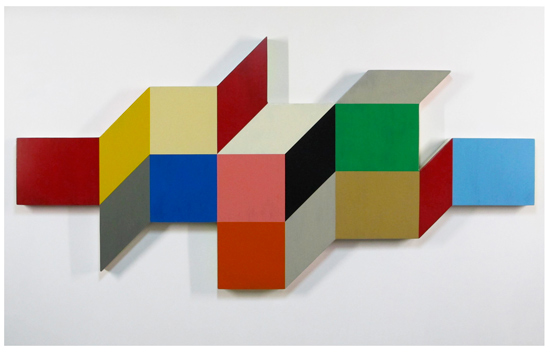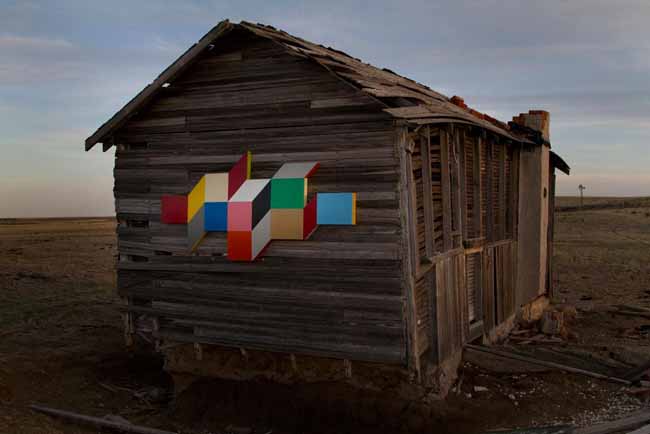
Saul’s Universe – Pard Morrison at James Kelly
Pard Morrison’s sculptures, currently on view at James Kelly Contemporary in Phantom Limbs, defy cubic assembly. Each spread of colorful squares unfolds from a central square. Perspectival lines sometimes look like preliminary childhood box constructions—four sides have three forty-five degree angles jutting out that end at a horizontal line and a perpendicular line. A regular four-sided square becomes a three-dimensional box all on a sheet of paper. Morrison’s sculptures waiver within this illusion, sometimes drawing, sometimes sculpture depending on how you look at it. Although hanging on the wall, each piece has a two to three inch deep edge that Morrison welded at 90 degrees to the flat plain of aluminum. These are mostly big, heavy objects made from metal and glazed in an oven with colors just shy of the primaries. The welded edge takes the place of those drawn forty-five degree angles, alluding to a third dimensional mirage that barely pushes the colorful plain away from the wall but casts a shadow underneath. From a distance, these pieces appear flat against the wall—not just held to it like a second skin but part of its surface, as if the wall itself opened into a vortex revealing really puzzling architectural blueprints. I think of Inside the White Cube except that these are neither white nor cubed. The stability of a perfect square is overthrown, usurped by a mathematical quandary that most certainly could not be used for any form of habitation.
In fact, Morrison does not map out these arrangements beforehand. Each piece of aluminum is cut out and then the shapes are drawn into their arrangement. It’s no wonder there’s not a single actual square in the show. The perfect, ideal square may be Phantom Limb’s phantom limb. I wonder if a calculator or ruler ever even enters into their creation, except to acquire a straight edge. Ironically, Morrison’s piece, Saul’s Universe, borrows its name from Saul Perlmutter, 2011’s Noble Prize winner in physics. A professor at the University of California, Berkley, Perlmutter is part of a team of scientists who announced in 1998 “that the expansion of the Universe was not slowing down due to gravity but was in fact accelerating.” Perlmutter’s universe is full of “dark matter,” the cause of the universal expansion. It’s called “dark matter” not because it’s evil witchcraft but because the scientists are literally “in the dark” about what it is and why it’s causing the expansion. The impact of this Nobel Prize winner on Morrison’s work may be equally obscure except to postulate that Saul’s Universe tends to expand from a single square into many, possibly ad infinitum. The center is a dusty rose pink square, which alludes to three-dimensionality through its black and white trail receding off the top right corner. From there, boxes keep popping up like a Jack-in-the-Box that perpetually pops out more boxes instead of Jack. Different colors painted on by hand with the help of masking tape offer a playground of foregrounds and backgrounds with sliding diamonds in between. Like most pieces in Phantom Limb, if you try to fold the squares logically in your head in hopes of forming a box, it’s just as confounding as Perlmutter’s physics.

At least with a Rubick’s cube, you know that all those extracurricular angles fit neatly inside the original configuration, even if you can’t necessarily get them there. In contrast, the marketing card for Phantom Limb offers a fun play of illusion. It shows Saul’s Universe hanging on a less than perfect specimen of architecture. An old barn, charming in its antiquity, rests on open plains with a picturesque sunset behind. Saul’s Universe hangs on the end, outside. The colors of the squares pick up the setting sun as if a nostalgic landscape and an architectural matrix have always labored side by side. But it is weird and one has to do a double-take. Morrion’s sculpture looks superimposed on the barn using Photoshop, but it’s not. Flattened by distance and by the camera lens, this awesome juxtaposition collapses the distance between mathematical certainty and the imperfect brown barn, elapsing the white cube into its gritty archenemy to create a more realistic, questionable existence. After all, does Saul’s universe expand forever or is there an end to bring us back to square one?

